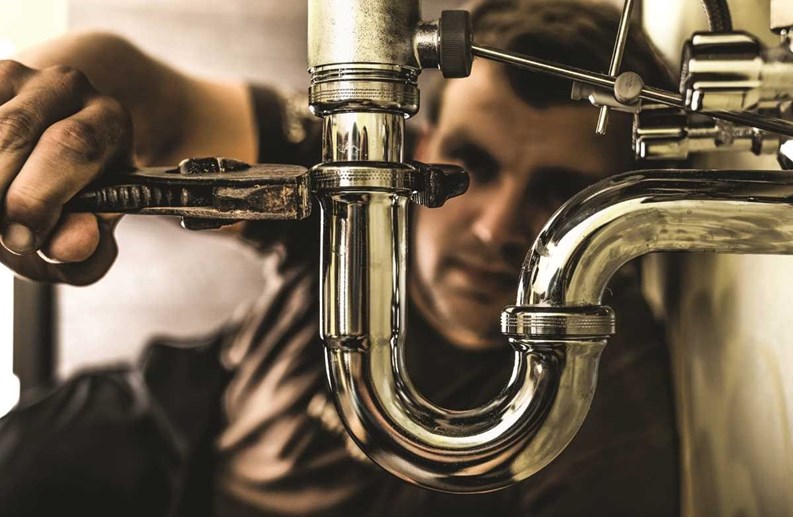Though mostly unseen, a building’s plumbing and piping network is one of its most important systems—as anyone who has ever had to endure a freezing February shower, or who has come home to a flooded floor, can attest. Plumbing includes not only hot water delivery, but water and waste removal—and not all plumbing is hidden. Some pipes snake across ceilings, or down walls inside individual units, making the plumbing more visible than the HVAC or electrical wiring in most buildings.
Plumbing is something many of us take for granted, until a faucet leaks, a sewer pipe bursts, a hot water heater dies, or another type of disaster befalls us.
H
2O HistoryThe word ‘plumber’ comes from the Latin root plumbum, meaning lead, which is why the chemical symbol for lead is PB. From its earliest days until the last century, plumbing systems were made almost exclusively of this soft metal, mainly due to its malleability. Lead, of course, can be poisonous—the use of lead pots and pans in ancient Rome contributed to its fall – and in the last half-century, plumbers have used other materials in its stead.
According to Linda Veiking of The Plumbing Museum in Watertown, Massachusetts, waste piping consisted of extra-heavy cast iron, joined together by lead, as recently as the 1970s. During that period, copper tubing was “Type M,” the thinnest available. Lead-based solder was eventually prohibited, once it was found to be leaking into the water supply, and Type M tubing was banned in favor of the wider Type L.
Certain changes in plumbing customs were dictated by economics. A boon in copper usage, for example directly stemmed from iron and steel becoming cost-prohibitive. By the late ’70s, plastic was incorporated into residential properties, although it remains illegal for use in commercial buildings.
In lieu of lead, piping was now joined via clamps, which were less expensive to produce and required less labor to construct. Clamps, press fits and grooves remain widely used even today, and, where gas piping is concerned, only a single coil is required, rendering joining unnecessary.
Back to the Present
Multifamily buildings traditionally featured shared plumbing systems, wherein the boiler room acts as a generating station for the entire building. Water was dispersed throughout the property, with the bill split evenly among residents as part of their maintenance charges. However, with an increase in water costs, many properties are moving toward charging owners on an individual basis. “In some cities, the landlord can have separate water meters for each tenant, with the corresponding bill arriving under that tenant’s name,” explains Veiking.
Modern condominiums allow the owner to control the water from inside the unit, via a mechanical room with an accessible hot water heater.
In regard to drainage, the once-dominant black ABS material has been replaced by the now-common white PVC, mostly based on the latter emerging as the more affordable of the two in recent years. Eric Beaudoin of Keith Beaudoin Plumbing in Fitchburg, Massachusetts, attributes the change in consumer preference to the simple law of supply and demand.
Modern Problems
While plumbing technology is constantly evolving, some problems nonetheless persist. For example, Beaudoin cites the fact that many older multifamily homes are still fitted with the out-of-date Type M copper piping.
“Type M is very thin, but it was cheap during its heyday, so of course they used it,” explains Beaudoin. “What we use now is actually an AquaPEX, or a plastic tubing for domestic water, which can only be used in multi-families of three units or less. If you have Type M copper, it’s best to have it replaced before pinhole leaks become major leaks. If you need to buy yourself some time, one quick fix is to take a piece of rubber—from an old tire, or something of that ilk—wrap it around the leak, and tighten the hose clamp. This will give you a couple of weeks until you can find a more permanent solution.”
Barry Keady, a business agent for UA Local 12, a plumbers and gas-fitters union in Boston, advises those evaluating plumber pricing not to settle for the lowest common denominator.
“You get what you pay for,” Keady says, “and with construction being so busy right now, a lot of the time plumbing contractors will hire unlicensed people who aren't skilled or equipped to do what needs be done in regard to proper plumbing standards, and they tend to take shortcuts, even installing piping that may be illegal.”
Keady also warns against not only cheap labor, but cheap products. "”f you’ve ever fixed your toilet,” he continues, “you’ll have noticed a ballcock that floats up and down to shut the water off whenever it runs. There’s something on that called a vacuum relief valve, which keeps the drain from sucking that toilet water into your house. A lot of places will sell replacement ballcocks that don't have this valve because it’s $3 cheaper. People who don't know any better will buy the cheaper one, and put themselves at risk.”
And of course, the plumber’s ostensible nemesis—that pesky leak—remains as persistent as ever. But while all pipes age and thus become increasingly susceptible to this inconvenience, Beaudoin has a trick to getting the most out of your current system.
“If you're working with proper piping, and you have discoloration that is, say, similar to the Statue of Liberty, which is made of copper, that aqua/green hue is because of oxidation, which eats away at a pipe from the outside in. One way to slow this process is to create a solution with baking soda and water, which will resemble a toothpaste. If you rub this on the acidic discoloration, let it sit for a few minutes, then wipe it off, that discoloration will disappear, and the copper will look nearly brand new. You’ve now neutralized the acidity, allowing the pipe a longer lifespan.”
Under Pressure
As anyone who has floundered under a seemingly inert shower head while trying to get a satisfying rinse can attest, low water pressure is a bane on the modern condo dweller. But before one tries to up the pressure, Keady suggests the problem may in fact have to do with the piping itself.
“Pressure is a simple measure of pounds per square inch,” he explains. “A lot of time, in cases of low water pressure, the problem is not one of pressure itself but one of volume. People often try to save money by utilizing a smaller and cheaper pipe size. The thing is, 60 lbs. of water pressure doesn't know if you have a 1/8 inch pipe or a 2-inch pipe. Regardless of the pressure, a smaller pipe leads to less flow. If you double the pipe diameter, you’ll have four times as much volume of water coming through. You can buy a pump to increase pressure in a condo, but if there’s not enough volume of water flowing through the pipes, all the pressure in the world won't help.”
Stitch in Time
One of the worst things that a homeowner can do to transform a minor plumbing inconvenience into a full-blown crisis is to turn a blind eye. If renting, a homeowner should let his or her tenant know, in no uncertain terms, that, should the tenant fear something is amiss, inform the owner immediately, lest a small drip become a steady stream.
“In our business, you realize very quickly that it’s much better to be proactive than it is to be reactive,” says Beaudoin. “You notice a tiny drip on your way to work, you ignore it, then you come home to find your entire floor submerged under two inches of water—water that is rapidly raining down onto the floor below. Now a fix that would have required a $10 part from Home Depot requires a restoration company, drying out and re-doing floors, sheet rock, installation, etc.” Ten dollars can turn to $10,000 surprisingly quickly.
The Plumbing Underground
Everything that runs through a condo sink, tub or toilet ends up in the same place—namely the sewer or the septic system. As with pipes and appliances, there are several care-taking measures that a condo owner or tenant can enact to help keep these systems at peak function.
Keady, for one, is an advocate of the latest low-flow toilets. “In 1986, when the 1.6 gallon toilet was first introduced, it didn’t work very well, and people were justifiably dissatisfied. All they actually did was reduce the amount of water that went through the toilet. As time went on, manufacturers realized that the toilet had to be completely re-engineered. Now, they’re actually at only 1.28 gallons, but they work fine. So you can save a lot of water volume with the new product lines, and that helps your water bill, your sewer bill, and your community.”
While plumbers are only responsible for troubles that exist within ten feet of a homeowner’s walls, they clearly carry some learned wisdom regarding sewer and septic maintenance. Beaudoin recommends checking the system regularly—say circa every six months—to make sure the level isn’t getting too high, and to have it pumped at similar intervals. If no one is maintaining that the tank doesn’t overflow, it will render flushing meaningless.
“You'll find that your downstairs, or sometimes your basement, toilet will not flush,” Beaudoin explains. “You’ll be flushing and flushing and it’s just backing up. Then you’ll call us to come snake your “drains, all to no avail, because you let the septic tank overflow."
How Handy Are the Handymen
In many issues of small malfunctions around the domicile, the homeowner is loathe to call in a professional when he or she can ostensibly repair the problem himself or herself, or, if it’s a slightly more aggravated issue, give the super or on-site handyman a ring. Plumbing, however, is a slippery slope, and what can seem like an easy fix now can lead to many headaches down the road.
“In Massachusetts, for example, you can’t legally do any plumbing work without being licensed,” notes Keady.
“There’s a reason that plumbers go to school for five years nowadays,” adds Beaudoin. “We are trained professionals who know what to look for and what not to look for.”
Beaudoin relates a recent incident wherein he was called to investigate a shower leak. A handyman had installed the client’s entire tub apparatus, and, because “he used a union trap instead of a closed-P trap"”when going up into the ceiling, a leak inevitably occurred, requiring the tearing down (and eventual replacement) of said ceiling in its entirety.
And both men stress the importance of contacting a trained pro in regard to any gas-related issue. “Every now and then you’ll hear that people have carbon monoxide in their house, and that’s because the plumber didn’t do something right with the boiler,” says Keady.
“When you get your plumbing license, you also become a licensed gas fitter, and there's a reason [the layman] shouldn’t play around with gas,” continues Beaudoin. “If you make a mistake, you”re not going to be around to see it.”
A Dirty Job
In the end, plumbing may sometimes be a dirty job—as Keady, who has seen "literally hundreds of people covered in sewage” can attest—but it’s also an intense profession that requires thorough training and a vast knowledge of the field. Homeowners should make sure that their vendors are licensed, insured and carrying their permits if they truly want the best service. Especially when taking shortcuts can lead to expensive—and unseemlydisasters.
As Keady puts it: “You never know what’s going to come out of a pipe, once you cut into it.”
Mike Odenthal is a staff writer for New England Condominium. Freelance writer Greg Olear also contributed to this article.







Leave a Comment